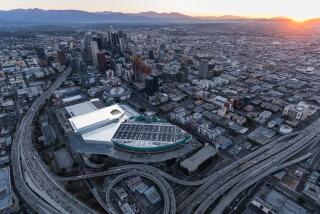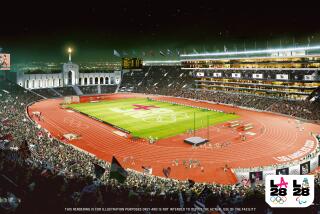Action Delayed on Del Mar Grandstand
DEL MAR â Despite testimony from a state architect that there is no way to correct the structural and safety deficiencies of the Del Mar Race Track grandstand except to tear it down and build a new one, a subcommittee of the state Race Track Leasing Commission voted Wednesday to put off action until another study is made.
Architect John Puisha told the commissioners that âdrastic surgeryâ is needed to bring the 50-year-old central part of the grandstand up to code, including earthquake safety and handicapped access requirements. But the commissioners decided they had insufficient information to sell the idea to the entire commission, which meets next August.
âThere is only one way to do it and that is to replace the grandstand,â Puisha said. âAny other way is economically not feasible and functionally not acceptable.â Puisha estimated that a 20,000-seat grandstand--more than double the size of the current grandstand--would cost $35 million, would provide better viewing of the finish line from its two-tiered seating, and would bring in more revenue than the existing 9,500-seat structure.
But Del Mar Fair Board Director Hugh Friedman, a commissioner, balked at giving the green light to a 20,000-seat facility until he is convinced that is the optimal size for a new grandstand.
âI want to know more about this plan if we are going to spend $1,500 a seat. Iâve heard the experts say that it should be replaced but no information on whether a 20,000-seat grandstand is what is needed,â he said.
Friedman also questioned whether the new grandstand could be built without cancellation of an annual county fair or a thoroughbred racing season.
The three members of the six-member commission formed to oversee expenditure of funds earned by thoroughbred racing at the track agreed to seek more information about the costs, benefits and funding sources for the grandstand before seeking full commission approval in August.
Joe Harper, general manager of the Del Mar Thoroughbred Club, which operates the seven-week racing season at the state-owned track, said that projections showing a need for a capacity of 50,000 racing fans by the year 2000 were ânot out of line.â The grandstand seats are sold out daily, he said, âand the only way we are going to grow is with a larger grandstand.â
The daily race attendance has leveled out at about 19,000, he said, and opening of a pedestrian tunnel to the infield is not expected to boost that figure. The infield, or central oval inside the race track, is being revamped to hold as many as 6,000 people.
Commissioners asked state architect Whitson Cox to conduct a hurry-up study to determine optimal size of the grandstand and what funding sources are available.
Puisha told the commission members that the need for a new grandstand had been known since 1968 but previous fair board and commission members had opted for âBand-Aidâ repairs instead of replacing the aging structure.
He warned commissioners that even if the go-ahead for a new grandstand was given in August, it would be 4 1/2 years before the project could be completed.
Friedman and fellow commissioner Raymond Saatjian stressed that any plan to build a new grandstand also would have to include planning for improved facilities to handle the larger crowds, including larger kitchen facilities, more parking and better automobile access to the fairgrounds from Interstate 5.
Included in a draft update of the state fairgrounds master plan are proposed off-ramps from I-5 south of Via de la Valle that would allow vehicles direct access to I-5 from fairgrounds parking lots.
More to Read
Go beyond the scoreboard
Get the latest on L.A.'s teams in the daily Sports Report newsletter.
You may occasionally receive promotional content from the Los Angeles Times.










